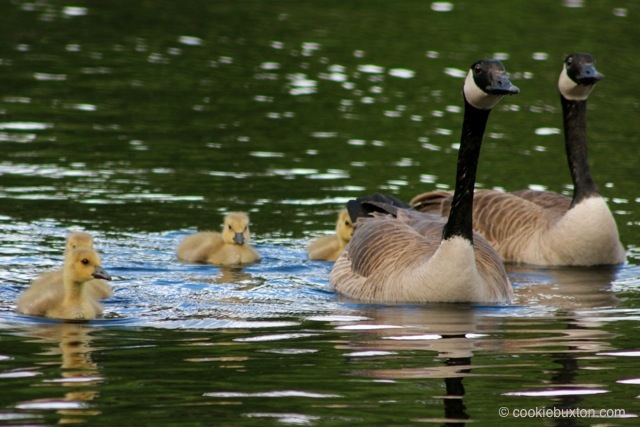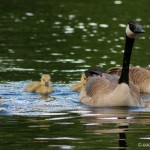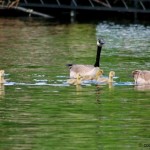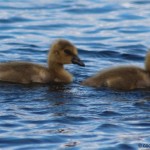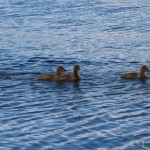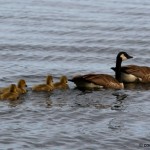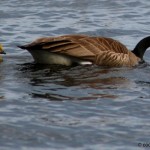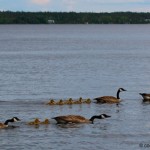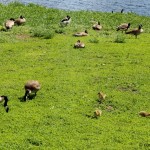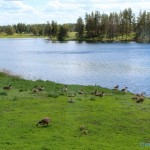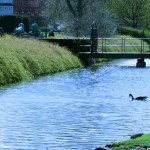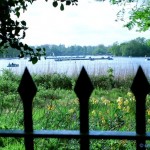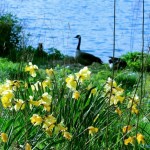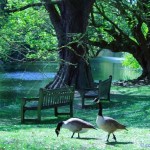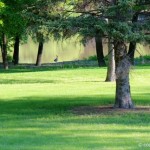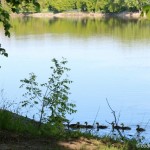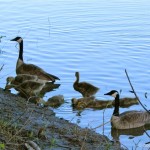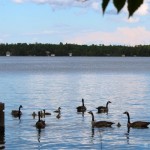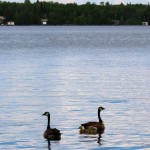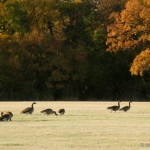Canada Goose, Branta canadensis
Canada Goose. Branta canadensis.
Most people I know pause and look up to the sky when they hear the distinctive honking of Canada Geese that are flying in V-formation overhead.
In the north, when the Canada Geese arrive in spring, they bring a sense of hope and renewal. When they leave their summer grounds, it creates a twinge of melancholy. It is, in part, knowing that cold days lie in front of us, rather than behind, but it is also simply that many of us will miss these handsome birds until they return again.
Perhaps you already know a fair bit about the Canada Goose. The Canada Goose species comprises a number of subspecies, such as the duck-sized Richardson Goose and the Giant Canada Goose. Sizes range from 55 to 122 centimetres in length, and up to 1.8 metres in wing span. The largest of the species, the powerful Giant, can weigh upwards of 11 kilograms. The Giant Canada Goose was almost extinct in the north until organized conservation efforts in Ontario, Minnesota, and Manitoba led to recovery through the rise of protection policies, education, and the establishment, within Manitoba alone, of such major nesting and migratory staging areas as the Alf Hole Goose Sanctuary in Whiteshell Park and Ducks Unlimited Canada’s Oak Hammock Marsh.
In appearance, it is their long black necks and white cheek or chin bands that set the Canada Goose species apart. I love seeing these geese in the wild, along shorelines of lakes and in the wetlands and beaver-dammed waterways in the Canadian Shield backcountry. More and more, we see them within urban boundaries, making themselves at home in golf courses and city parks. It is interesting to watch a large group of geese grazing in these areas. You will typically see the biggest birds facing outwards, each facing in a different direction, keeping watchful guard while other birds are grazing.
Of particular interest, because it is rare, is that Canada Geese establish lifelong pair-bonds. Evidently, if the partner dies, the partner will mate again but, otherwise, they stay together for their lifetimes. Years ago, on a canoe trip in the late fall when the geese were migrating to their wintering grounds in Mexico, my husband and I saw a goose that had been wounded by gunshot struggling in the tall grasses near a wide stream. Its partner stayed nearby in the underbrush. We don’t know how long that story lasted, but it was heartbreaking to see. Geese typically live for many years, returning to their customary grounds, expanding family groupings, and living together within what appears to be a well organized social structure.
Last season, while at Lake Brereton in Manitoba’s Whiteshell Park, we saw two pairs of adult geese with several goslings. This year, at the same location, there were eight adults and about a dozen goslings, all travelling the same stretch of shoreline in a large group. I’ve included some photographs of this particular family unit in my Photo Gallery album.
I admire these interesting birds. I love the sound of their musical honking; I love to watch their V flight formations; I like how they organize themselves on land and in the air; and I like how they keep watch over one another. They are really quite special. When they come home, each spring, my heart lifts.
Resources:
Hinterland’s Who’s Who
Roger Tory Peterson’s A Field Guide to the Birds
Sndy Bezener & Ken DeSmet, Lone Pine’s Manitoba Birds
Photos: NK, AK
Photo locations: We saw the occasional Canada Goose pairing while travelling in Denmark and England in spring 2014. Photographs include: a Canada Goose in the moat at Kongen’s Have in Copenhagen; one of several on Hyde Lake in London; a pair along a waterway in Kew Gardens. Other images are taken in Manitoba, Canada.
Manitoba’s Lake Brereton, Red River, Assiniboine Park; Copenhagen’s Kongens Have; London’s Hyde Park, Kew Gardens.
Text: NK
Copyright: cookiebuxton
Photo Gallery:
Click on any image to enlarge. Click on the enlarged photograph to advance through the series.
- Canada Geese on Lake Brereton, Manitoba
- at Lake Brereton, Manitoba
- Alf Hole Goose Sanctuary
- Alf Hole Goose Sanctuary
- Kongens Have, Copenhagen
- Hyde Park, London
- Hyde Park, London
- Kew Gardens, London
- Red River, Winnipeg
- Red River
- Red Winter
- Lake Brereton, 2014
- Lake Brereton
- Assiniboine Park
